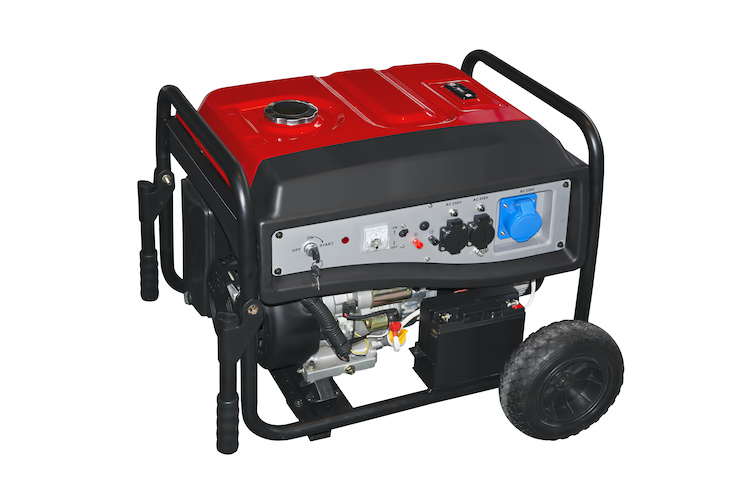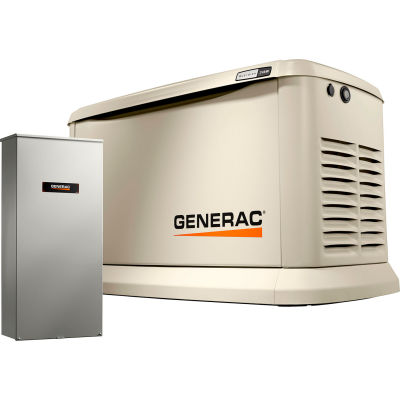Portable and standby generators for your home
One of the most common reasons people consider purchasing a generator is because they are looking to maintain access to power in the case of a power outage. If that’s the case, your most common options are standby generators or portable generators.
If you’re looking for a generator, but are not sure where to start, weigh all of the pros and cons, costs and maintenance involved when making your buying decision.
Portable generators
What are portable generators?
Portable generators are best used as a short-term solution. They can be moved from place and are affordable, easy to use and most models typically run on the same gasoline as your car or lawn mower. Portable generators are smaller and generally have wheels so they can be easily moved and stored when not in use. They must be started manually with either a pull-start engine or an electric start button.
A portable generator provides backup power in the event of power outages, but these only provide a limited supply of electricity and require regular oversight to keep fueled and running. These generators cost significantly less than standby generators, but they also provide less power than a standby generator.
If you typically only experience infrequent/short outages and are on a tight budget, or want a generator for multiple purposes, a portable generator may be the right fit for you.
Portable generators:
PROS
- Can power lights and appliances in a power outage situation
- Are more inexpensive than standby generators
- Doesn’t take up permanent yard space
- Require less maintenance than a standby generator
CONS
- Manual usage
- Produce less power (typically won’t power the entire home)
- Gives off carbon monoxide when in use, so cannot be used indoors/or in garage
- If your electricity is out for several days, they can become expensive to run
- Requires separate fuel storage
- Can be heavy and difficult to move
- Noisy when running
Portable generators safety:
- If you decide to use a portable generator during an outage, make sure it is placed outside of the home during any use for proper ventilation (never use it inside your home or garage).
- If you use a generator, connect the equipment you want to the outlets on the generator. Never connect a portable generator to your home’s electrical system unless you have a manual transfer switch (this must be installed by a professional).
- Never run a generator closer than 20 feet from the doors and windows to prevent fumes from entering the home.
- Make sure to read the owner instruction manual and follow all the instructions listed.
- Start the generator before connecting appliances.
- Use a heavy-duty extension cord to connect electrical appliances to the outlet on the generator.

Standby generators
What are standby generators?
Standby (stationary) generators are permanent fixtures that must be installed professionally. They are always on standby, which means that when your home loses power, these generators automatically turn on, even if you’re not there.
The automatic transfer switch disconnects the electricity utility and connects the generator to the home’s electrical system. As soon as normal power is restored, your standby generator will automatically switch back off and continue to remain ready for the next emergency. These are the most automated way to keep your home running during an outage, but they are a significant investment.
These generators typically run on either natural gas or propane and and are installed on their own concrete foundation. They can be sized to adequately power your home during an outage. In most cases, your installer will talk to you about your home’s energy usage and help you choose the correct size. They also run diagnostics automatically to let you know when maintenance is needed, so they require less hands-on attention than portable generators.
Factors to consider before installing a standby generator
While generators can provide peace of mind, they aren’t utilized very often and can be neglected if not maintained properly. If you have long/frequent outages and don’t mind paying for a fully-automatic system, a standby generator makes a lot more sense than a portable generator.
Standby and portable generators both produce some degree of noise—however, portable generators tend to be slightly louder than standby generators. That being said, even standby generators can be heard throughout the home when they are running.
A standby generator runs for approximately 15 minutes once a week to determine if maintenance is required. It can be heard during this time, so you may want your technician to schedule this during daytime hours when you are not at home.
PROS
- It is a backup power source that kicks in automatically
- Are quieter than portable generators (but still produces noise when running)
- A more permanent solution than portables
CONS
- Significant investment (and will include both a unit purchase plus installation)
- Takes up outdoor space
- Requires maintenance and periodic service
- Are wired directly into your home’s electrical system, so it can’t be relocated
When choosing a generator for your house, take into account what you intend to power while the electricity is out and calculate the wattage of those appliances or systems with your installer to figure out what you would need in an emergency.
Because these generators are permanent additions to your home, you’ll need to check property tax, building permit and code requirements before installation.

Standby (Fixed) Generator Connected to Home Electrical Service
Standby generators are usually propane or natural gas and are installed on their own concrete foundation. These installations need a mechanism for not back-feeding into the wider electrical system. This can either be a transfer switch or an interlock switch.
Interlocking switch: An interlock switch is installed on your main service panel and physically prevents the main breaker from remaining in the closed position when the breaker for the generator is closed. It is not until the main breaker is opened that the generator breaker can physically be closed.
Transfer switch: A standard main service panel is installed right after the meter. A transfer switch would be installed between the meter and the main panel. It serves as the means to safely swap between the traditional utility electric grid and the local generator
A transfer switch can either be automatic, the generator turns itself on and the service swaps over to the generator supply by itself, or manual, the homeowner would need to flip switches similar to a breaker.
Either of these solutions should be installed by qualified individuals as they are both subject to dangerous live voltage during the installation process.
A transfer switch involves KPUB temporarily disconnecting service so that the electrical service can be safely reconfigured.
Without these mechanisms in place, power from your generator can be pushed upstream onto the wider electrical system and create a safety hazard for our crews.
